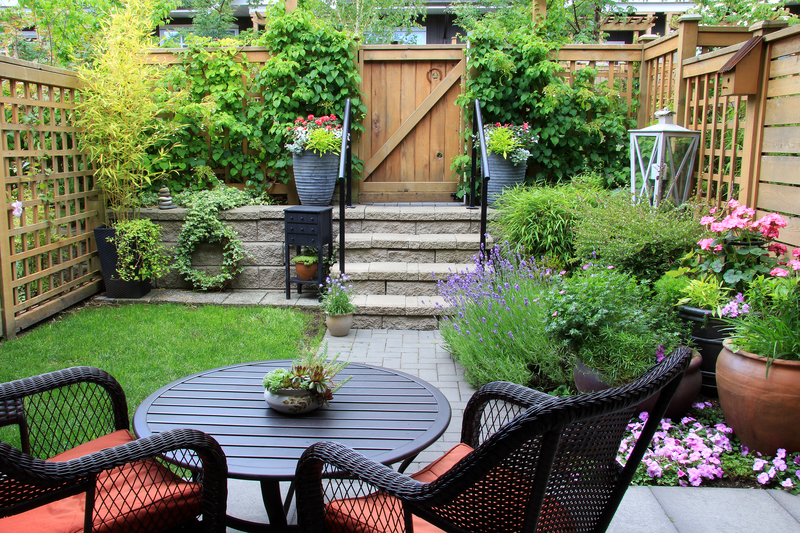Methods to Defend Your Garden from Severe Weather Impact
Posted on 21/05/2025
Methods to Defend Your Garden from Severe Weather Impact
Gardening is a rewarding activity that connects us with nature and provides a sense of accomplishment. However, severe weather events can, in just a few hours or days, undo months or even years of hard work. Learning effective methods to defend your garden from severe weather impacts is crucial for both novice and experienced gardeners. In this comprehensive guide, we cover practical and actionable strategies to safeguard your garden from wind, rain, frost, drought, hail, and other extreme weather conditions.
Understanding the Threats: Types of Severe Weather That Affect Gardens
Before implementing protective measures, it's important to recognize the various types of weather that can impact your garden. By identifying specific threats, you can select the most effective solutions to minimize damage and foster plant resilience.
Common Severe Weather Events That Endanger Gardens
- Heavy Rain and Flooding - Can wash away soil, drown plant roots, and spread disease.
- High Winds and Storms - Can break stems, uproot plants, and damage structures.
- Frost and Freezing Temperatures - Can kill sensitive plants and disrupt growth cycles.
- Heatwaves and Drought - Cause dehydration, wilting, and heat stress in plants.
- Hail - Physically damages foliage, flowers, and fruits.
With these threats in mind, let's explore a variety of methods to protect your garden from extreme weather.

1. Strategic Garden Planning for Weather Resilience
Garden layout and plant selection are the first steps in weather-proofing your outdoor space. By making wise decisions at the outset, you can greatly minimize potential damage from severe conditions.
Selecting Weather-Resistant Plants
- Native Species: Choose plants that are indigenous to your region; they are adapted to local weather patterns and generally require less maintenance.
- Drought-Tolerant Choices: Consider succulents, sedums, and deep-rooted perennials for areas prone to dry spells.
- Cold-Hardy Varieties: Opt for frost-resistant vegetables and ornamental plants in colder climates.
Site Selection and Microclimates
- Sheltered Locations: Place sensitive plants in areas protected from prevailing winds and excessive sun exposure.
- Elevation and Drainage: Avoid low-lying areas that collect water; elevate vulnerable beds to prevent root rot.
Windbreaks and Natural Barriers
- Hedges and Shrubs: Plant dense borders (like boxwood or privet) to shield from strong wind gusts.
- Fences and Trellises: Use sturdy structures to provide additional wind protection and support for climbers.
Smart garden design is the foundation of minimizing the impact of severe weather.
2. Soil Preparation and Maintenance for Weather Defense
Healthy, well-structured soil can help your garden withstand challenging weather more effectively.
Improving Drainage
- Organic Matter: Regularly add compost or well-rotted manure to improve soil structure and drainage, reducing the risks of waterlogging during heavy rain.
- Raised Beds: Construct raised beds to enhance runoff and protect roots from sitting water.
- Mulching: Apply a layer of organic mulch (such as wood chips, straw, or leaves) to both insulate the soil and reduce erosion during storms.
Soil Erosion Control Techniques
- Ground Covers: Plant low-growing cover crops (clover, creeping thyme) to reduce bare soil exposure.
- Terracing: On slopes, create terraces to slow water runoff and retain soil.
Soil health boosts plant resilience, making your garden better equipped to survive harsh conditions.
3. Defending Against Wind and Storm Damage
Storms and wind can quickly devastate a garden, but several garden weather protection methods can provide crucial defense.
Windbreak Structures
- Temporary Barriers: Erect burlap screens, shade cloth, or plastic sheeting on the windward side of your garden during particularly fierce storms.
- Living Windbreaks: Fast-growing shrubs and trees planted to block wind over time while enhancing biodiversity.
Securing Plants and Structures
- Staking: Use ties and stakes to support young trees and tall plants (such as tomatoes, sunflowers), preventing them from bending or breaking in the wind.
- Pruning: Regularly remove weak or dead branches that are likely to snap during storms.
- Reinforce Garden Structures: Check that fences, trellises, and pergolas are securely anchored before storm season begins.
Protecting Delicate Plants During Storms
- Moveable Containers: Shift potted plants to sheltered locations (against a wall, or even indoors) during storm warnings.
- Covering with Cloche or Dome: Place cloches, plastic domes, or even upturned buckets over young or low-growing plants to shield from wind and driving rain.
Being proactive is the key when defending your garden from high winds and storms.
4. Rain, Flood, and Water Management
While rain is vital for gardens, excessive moisture leads to many problems. Implementing smart water management practices helps to protect your garden from excessive rainfall and flooding.
Enhancing Garden Drainage
- Installing French Drains: A trench filled with gravel and a perforated pipe helps divert water away from plant beds.
- Rain Gardens: Create a shallow basin planted with water-loving species that absorb excess runoff.
Raised Beds and Containers
- Use Raised Beds: Keeping root zones above the surrounding ground can prevent waterlogging and root rot.
- Pots with Drainage Holes: Ensure containers have adequate drainage to avoid pooling water.
Gutter and Downspout Management
- Direct Water Away: Make sure downspouts channel water away from the garden's vulnerable sections.
- Rain Barrels: Collect rooftop runoff in barrels, conserving water for future dry spells and reducing flooding risks.
Managing water flow in your garden is a fundamental aspect of weatherproofing.
5. Frost and Freeze Protection Methods
Unexpected frosts can strike even mild climates. Use these frost protection techniques for gardens to keep your plants safe:
Season Extension Tools
- Row Covers: Lightweight fabric covers (such as frost cloth or floating row covers) trap warmth without blocking sunlight.
- Cold Frames and Mini-Greenhouses: Build small, transparent shelters to protect tender plants and seedlings from cold snaps.
Traditional Frost Protection Tips
- Watering Before Frost: Damp soil holds heat better than dry, so thoroughly water in advance of a frost warning.
- Mulching: An extra-deep layer of mulch around roots shelters them from temperature swings.
- Using Cloches and Jugs: Place upturned glass or plastic containers over delicate blossoms at night; plastic milk jugs with bottoms cut out make good, reusable covers.
Prompt frost protection often spells the difference between survival and loss during sudden cold events.
6. Coping with Heatwaves and Drought
Long, hot, dry periods can exhaust both plants and gardeners. Proactive techniques help defend your garden from drought and heat stress:
Efficient Watering Practices
- Drip Irrigation and Soaker Hoses: Deliver water directly at the root zone, minimizing waste and evaporation.
- Early Morning Watering: Water early in the day to allow plants to absorb moisture before peak sun.
- Group by Water Needs: Plant species with similar watering requirements together for easier management.
Shade and Cooling Solutions
- Temporary Shade Cloth: Drape over susceptible beds or containers to reduce solar intensity.
- Living Mulch and Ground Covers: Use sprawling, dense plants to shade soil and roots naturally.
Soil Moisture Conservation
- Mulching: A thick layer of organic material slows evaporation and keeps roots cool.
- No-till Practices: Minimizing soil disturbance helps retain precious moisture.
Beat the heat by combining smart watering and shading techniques.
7. Hail Protection Strategies
Hail can appear abruptly and cause devastating damage in minutes. To safeguard your garden from hailstorms, try these quick defenses:
Physical Barriers
- Protective Netting: Secure hail-resistant netting or hardware cloth over vulnerable plants when a storm is forecast.
- Use Row Covers: Heavy-duty floating row covers offer decent protection against smaller hailstones.
- Moveable Shelters: Wheel or slide portable greenhouses or frames over container gardens or small beds.
Emergency Hail Shields
- Lightweight Materials: Drop old bedsheets, tarps, or even cardboard over plants for short-term protection (remove once hail threat passes).
Temporary coverings, quickly deployed, are your best hail defense during a sudden storm.
8. Long-Term Garden Weatherproofing Tips
Defending your garden is not just a one-time event - it requires ongoing attention and adaptation. Consider these long-term approaches:
Regular Garden Inspection
- Monitor for Vulnerabilities: Check after every major weather event for damage, disease, or erosion so you can respond quickly.
- Soil Testing: Periodically test soil health to maintain high fertility and drainage capacity.
Flexible Garden Structures
- Removable Screens and Panels: Modular barriers are easy to erect or dismantle as needed.
- Portable Planting: Use containers that can be relocated in anticipation of extreme weather forecasts.
Resilience Through Diversity
- Plant Variety: Grow a mix of species and cultivars, so losses in one area don't threaten your entire garden.
- Encourage Beneficial Insects and Pollinators: A healthy ecosystem helps your garden recover more quickly from weather stress.
Resilience is built through preparation, observation, and adaptation. Over time, your garden will become stronger in the face of unpredictable weather shifts.

Conclusion: Prioritize Weather Protection for a Thriving Garden
Climate extremes are inevitable, but the damage they cause is not. By implementing these methods to defend your garden from severe weather impact, you can preserve your landscape's beauty and productivity year-round. From careful planning and resilient planting to quick emergency measures and ongoing surveillance, each strategy brings you one step closer to a truly weatherproof garden.
With informed preparation and a flexible mindset, nature's fiercest elements become just another gardening challenge - one you are well-equipped to meet.
FAQs: Frequently Asked Questions About Defending Gardens from Severe Weather
What is the best way to protect a vegetable garden during a storm?
Secure plants with stakes, use row covers, and place mulch to prevent soil erosion. For container gardens, move pots indoors or to a sheltered spot.
How can I minimize water damage after heavy rain?
Ensure good drainage by using raised beds, installing French drains, and planting rain gardens to divert excess water.
What's the easiest way to protect flowers from frost?
Cover with lightweight row covers or cloches at night and ensure soil is moist before a frost is expected.
Are there specific plants that can survive both drought and floods?
Some native grasses and perennials, such as daylilies or black-eyed Susans, offer remarkable adaptability. However, most plants have a preference; know your local climate and select accordingly.
Remember: Being prepared is your best defense against severe weather in the garden.

